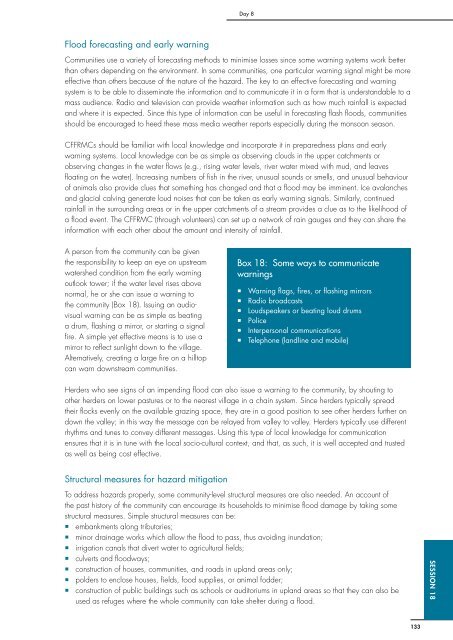Flash Flood Risk Management â A Training of Trainers ... - ReliefWeb
Flash Flood Risk Management â A Training of Trainers ... - ReliefWeb
Flash Flood Risk Management â A Training of Trainers ... - ReliefWeb
Create successful ePaper yourself
Turn your PDF publications into a flip-book with our unique Google optimized e-Paper software.
Day 8<br />
<strong>Flood</strong> forecasting and early warning<br />
Communities use a variety <strong>of</strong> forecasting methods to minimise losses since some warning systems work better<br />
than others depending on the environment. In some communities, one particular warning signal might be more<br />
effective than others because <strong>of</strong> the nature <strong>of</strong> the hazard. The key to an effective forecasting and warning<br />
system is to be able to disseminate the information and to communicate it in a form that is understandable to a<br />
mass audience. Radio and television can provide weather information such as how much rainfall is expected<br />
and where it is expected. Since this type <strong>of</strong> information can be useful in forecasting flash floods, communities<br />
should be encouraged to heed these mass media weather reports especially during the monsoon season.<br />
CFFRMCs should be familiar with local knowledge and incorporate it in preparedness plans and early<br />
warning systems. Local knowledge can be as simple as observing clouds in the upper catchments or<br />
observing changes in the water flows (e.g., rising water levels, river water mixed with mud, and leaves<br />
floating on the water). Increasing numbers <strong>of</strong> fish in the river, unusual sounds or smells, and unusual behaviour<br />
<strong>of</strong> animals also provide clues that something has changed and that a flood may be imminent. Ice avalanches<br />
and glacial calving generate loud noises that can be taken as early warning signals. Similarly, continued<br />
rainfall in the surrounding areas or in the upper catchments <strong>of</strong> a stream provides a clue as to the likelihood <strong>of</strong><br />
a flood event. The CFFRMC (through volunteers) can set up a network <strong>of</strong> rain gauges and they can share the<br />
information with each other about the amount and intensity <strong>of</strong> rainfall.<br />
A person from the community can be given<br />
the responsibility to keep an eye on upstream<br />
watershed condition from the early warning<br />
outlook tower; if the water level rises above<br />
normal, he or she can issue a warning to<br />
the community (Box 18). Issuing an audiovisual<br />
warning can be as simple as beating<br />
a drum, flashing a mirror, or starting a signal<br />
fire. A simple yet effective means is to use a<br />
mirror to reflect sunlight down to the village.<br />
Alternatively, creating a large fire on a hilltop<br />
can warn downstream communities.<br />
Box 18: Some ways to communicate<br />
warnings<br />
• Warning flags, fires, or flashing mirrors<br />
• Radio broadcasts<br />
• Loudspeakers or beating loud drums<br />
• Police<br />
• Interpersonal communications<br />
• Telephone (landline and mobile)<br />
Herders who see signs <strong>of</strong> an impending flood can also issue a warning to the community, by shouting to<br />
other herders on lower pastures or to the nearest village in a chain system. Since herders typically spread<br />
their flocks evenly on the available grazing space, they are in a good position to see other herders further on<br />
down the valley; in this way the message can be relayed from valley to valley. Herders typically use different<br />
rhythms and tunes to convey different messages. Using this type <strong>of</strong> local knowledge for communication<br />
ensures that it is in tune with the local socio-cultural context, and that, as such, it is well accepted and trusted<br />
as well as being cost effective.<br />
Structural measures for hazard mitigation<br />
To address hazards properly, some community-level structural measures are also needed. An account <strong>of</strong><br />
the past history <strong>of</strong> the community can encourage its households to minimise flood damage by taking some<br />
structural measures. Simple structural measures can be:<br />
• embankments along tributaries;<br />
• minor drainage works which allow the flood to pass, thus avoiding inundation;<br />
• irrigation canals that divert water to agricultural fields;<br />
• culverts and floodways;<br />
• construction <strong>of</strong> houses, communities, and roads in upland areas only;<br />
• polders to enclose houses, fields, food supplies, or animal fodder;<br />
• construction <strong>of</strong> public buildings such as schools or auditoriums in upland areas so that they can also be<br />
used as refuges where the whole community can take shelter during a flood.<br />
session 18<br />
133

















